Identification of the Urban Dry Islands Effect in Beijing: Evidence from Satellite and Ground Observations
Abstract
:1. Introduction
2. Materials and Methods
2.1. Total-Column Precipitation Water Vapor
2.2. Station-Observed Humidity Indicators
2.3. Atmospheric Humidity Profile
2.4. Urban Dry Islands Intensity Calculation
3. Results
3.1. Urban–Rural Differences in Total-Column Humidity
3.2. Urban–Rural Differences in Near-Surface Humidity
3.3. Urban–Rural Differences in Atmospheric Humidity
4. Discussion
5. Conclusions
Author Contributions
Funding
Institutional Review Board Statement
Informed Consent Statement
Data Availability Statement
Conflicts of Interest
Appendix A
| Data | Product | Resolution | Year | Website |
|---|---|---|---|---|
| Land use/land cover | MODIS MCD12Q1 | 500 m | 2003–2018 | https://ladsweb.modaps.eosdis.nasa.gov (accessed on 5 April 2020) |
| Total-column precipitation water vapor | MODIS MOD05_L2 MODIS MYD05_L2 | 1 km | 2003–2019 | https://ladsweb.modaps.eosdis.nasa.gov (accessed on 5 April 2020) |
| Atmospheric profile | MODIS MOD07_L2 MODIS MYD07_L2 | 5 km | 2003–2019 | https://ladsweb.modaps.eosdis.nasa.gov (accessed on 5 April 2020) |
| Station-based observation | — | — | 2008–2019 | http://data.cma.cn/ (accessed on 10 April 2020) |

References
- Kalnay, E.; Cai, M. Impact of urbanization and land-use change on climate. Nature 2003, 423, 528–531. [Google Scholar] [CrossRef] [PubMed]
- Oke, T.R. Towards better scientific communication in urban climate. Theor. Appl. Clim. 2006, 84, 179–190. [Google Scholar] [CrossRef]
- Georgescu, M.; Miguez-Macho, G.; Steyaert, L.T.; Weaver, C.P. Climatic effects of 30 years of landscape change over the Greater Phoenix, Arizona, region: 1. Surface energy budget changes. J. Geophys. Res. Atmos. 2019, 114, D05110. [Google Scholar]
- Georgescu, M.; Miguez-Macho, G.; Steyaert, L.T.; Weaver, C.P. Climatic effects of 30 years of landscape change over the Greater Phoenix, Arizona, region: 2. Dynamical and thermo-dynamical response. J. Geophys. Res. Atmos. 2019, 114, D05111. [Google Scholar] [CrossRef] [Green Version]
- Liu, X.; Hu, G.; Chen, Y.; Li, X.; Xu, X.; Li, S.; Pei, F.; Wang, S. High-resolution multi-temporal mapping of global urban land using Landsat images based on the Google Earth Engine Platform. Remote Sens. Environ. 2018, 209, 227–239. [Google Scholar] [CrossRef]
- Seto, K.C.; Golden, J.S.; Alberti, M.; Turner, B.L. Sustainability in an urbanizing planet. Proc. Natl Acad. Sci. USA 2017, 114, 8935–8938. [Google Scholar] [CrossRef] [Green Version]
- Mills, G. Cities as agents of global change. Int. J. Clim. 2007, 27, 1849–1857. [Google Scholar] [CrossRef]
- Grimm, N.B.; Faeth, S.H.; Golubiewski, N.E.; Redman, C.L.; Wu, J.; Bai, X.; Briggs, J.M. Global change and the ecology of cities. Science 2008, 319, 756–760. [Google Scholar] [CrossRef] [Green Version]
- Seto, K.C.; Shepherd, J.M. Global urban land-use trends and climate impacts. Curr. Opin. Environ. Sustain. 2009, 1, 89–95. [Google Scholar] [CrossRef]
- Bai, X.; Dawson, R.J.; Ürge-Vorsatz, D.; Delgado, G.C.; Barau, A.S.; Dhakal, S.; Dodman, D.; Leonardsen, L.; Masson-Delmotte, V.; Roberts, D.C.; et al. Six research priorities for cities and climate change. Nature 2018, 555, 23–25. [Google Scholar] [CrossRef]
- Cao, Q.; Liu, Y.; Georgescu, M.; Wu, J.G. Impacts of landscape changes on local and regional climate: A systematic review. Landsc. Ecol. 2020, 35, 1269–1290. [Google Scholar] [CrossRef]
- Brazel, A.; Gober, P.; Lee, S.; Grossman-Clarke, S.; Zehnder, J.; Hedquist, B.; Comparri, E. Determinants of changes in the regional urban heat island in metropolitan Phoenix (Arizona, USA) between 1990 and 2004. Clim. Res. 2007, 33, 171–182. [Google Scholar] [CrossRef] [Green Version]
- Buyantuyev, A.; Wu, J.G. Urban heat islands and landscape heterogeneity: Linking spatio-temporal variations in surface temperatures to land-cover and socioeconomic patterns. Landsc. Ecol. 2010, 25, 17–33. [Google Scholar] [CrossRef]
- Myint, S.W.; Wentz, E.A.; Brazel, A.J.; Quattrochi, D.A. The impact of distinct anthropogenic and vegetation features on urban warming. Landsc. Ecol. 2013, 28, 959–978. [Google Scholar] [CrossRef] [Green Version]
- Sharma, A.; Fernando, H.J.; Hamlet, A.F.; Hellmann, J.J.; Barlage, M.; Chen, F. Urban meteo-rological modeling using WRF: A sensitivity study. Int. J. Clim. 2017, 37, 1885–1900. [Google Scholar] [CrossRef]
- He, B. Potentials of meteorological characteristics and synoptic conditions to mitigate urban heat island effects. Urban Clim. 2018, 24, 26–33. [Google Scholar] [CrossRef]
- Shepherd, J.M.; Carter, M.; Manyin, M.; Messen, D.; Burian, S. The impact of urbanization on current and future coastal precipitation: A case study for Houston. Environ. Plan. B Plan. Des. 2010, 37, 284–304. [Google Scholar] [CrossRef] [Green Version]
- Niyogi, D.; Pyle, P.; Lei, M.; Arya, S.P.; Kishtawal, C.M.; Shepherd, M.; Chen, F.; Wolfe, B. Urban modification of thunderstorms: An observational storm climatology and model case study for the Indianapolis urban region. J. Appl. Meteorol. Clim. 2011, 50, 1129–1144. [Google Scholar] [CrossRef]
- Kusaka, H.; Nawata, K.; Suzuki-Parker, A.; Takane, Y.; Furuhashi, N. Mechanism of precipitation increase with urbanization in Tokyo as revealed by ensemble climate simulations. J. Appl. Meteorol. Clim. 2014, 53, 824–839. [Google Scholar] [CrossRef]
- Wang, J.; Feng, J.; Yan, Z. Impact of extensive urbanization on summertime rainfall in the Beijing region and the role of local precipitation recycling. J. Geophys. Res. Atmos. 2018, 123, 3323–3340. [Google Scholar] [CrossRef]
- Pielke, R.A.; Niyogi, D. The role of landscape processes within the climate system. In Landform-Structure, Evolution, Process Control: Proceedings of the International Symposium on Landform Organized by the Research Training Group 437; Otto, J.C., Dikau, R., Eds.; Springer: Berlin, Germany, 2010; pp. 67–85. [Google Scholar]
- Shaman, J.; Pitzer, V.E.; Viboud, C.; Grenfell, B.T.; Lipsitch, M. Absolute humidity and the seasonal onset of influenza in the continental United States. PLoS Biol. 2010, 8, e1000316. [Google Scholar] [CrossRef]
- Novick, K.A.; Ficklin, D.L.; Stoy, P.C.; Williams, C.A.; Bohrer, G.; Oishi, A.C.; Papuga, S.A.; Blanken, P.D.; Noormets, A.; Sulman, B.N.; et al. The increasing importance of atmospheric demand for ecosystem water and carbon fluxes. Nat. Clim. Chang. 2016, 6, 1023–1027. [Google Scholar] [CrossRef] [Green Version]
- Le Page, Y.L.; Morton, D.; Hartin, C.; Bond-Lamberty, B.; Pereira, J.M.C.; Hurtt, G.; Asrar, G. Synergy between land use and climate change increases future fire risk in Amazon forests. Earth Syst. Dyn. 2017, 8, 1237–1246. [Google Scholar] [CrossRef] [Green Version]
- Kratzer, P.A. The Climate of Cities; Friedrich Vieweg & Sohn: Berlin, Germany, 1956; p. 184. [Google Scholar]
- Hilberg, S.D. Diurnal temperature and moisture cycles. Summ. METROMEX 1978, 2, 25–42. [Google Scholar]
- Hage, K.D. Urban-rural humidity differences. J. Appl. Meteorol. Clim. 1975, 14, 1277–1283. [Google Scholar] [CrossRef]
- Sakakibara, Y. Features of water vapor pressure difference between urban and rural in Obuse, Nagano. Tenki 2001, 48, 151–158. [Google Scholar]
- Moriwaki, R.; Watanabe, K.; Morimoto, K. Urban dry island phenomenon and its impact on cloud base level. J. JSCE 2013, 1, 521–529. [Google Scholar] [CrossRef] [Green Version]
- Ackerman, B. Climatology of Chicago area urban-rural differences in humidity. J. Appl. Meteorol. Clim. 1987, 26, 427–430. [Google Scholar] [CrossRef]
- Lee, D.O. Urban-rural humidity differences in London. Int. J. Clim. 1991, 11, 577–582. [Google Scholar] [CrossRef]
- Cuadrat, J.M.; Vicente-Serrano, S.; Saz, M.A. Influence of different factors on relative air humidity in Zaragoza, Spain. Front. Earth Sci. 2015, 3, 10. [Google Scholar] [CrossRef] [Green Version]
- Lokoshchenko, M.A. Urban heat island and urban dry island in Moscow and their centennial changes. J. Appl. Meteorol. Clim. 2017, 56, 2729–2745. [Google Scholar] [CrossRef]
- Yang, P.; Ren, G.; Hou, W. Temporal-spatial patterns of relative humidity and the urban dryness island effect in Beijing City. J. Appl. Meteorol. Clim. 2017, 56, 2221–2237. [Google Scholar] [CrossRef]
- Hao, L.; Huang, X.; Qin, M.; Liu, Y.; Li, W.; Sun, G. Ecohydrological processes explain urban dry island effects in a wet region, southern China. Water Resour. Res. 2018, 54, 6757–6771. [Google Scholar] [CrossRef]
- Luo, M.; Lau, N.C. Urban expansion and drying climate in an urban agglomeration of east China. Geophys. Res. Lett 2019, 46, 6868–6877. [Google Scholar] [CrossRef]
- Lin, L.; Chan, T.O.; Ge, E.; Wang, X.; Zhao, Y.; Yang, Y.; Ning, G.; Zeng, Z.; Luo, M. Effects of urban land expansion on decreasing atmospheric moisture in Guangdong, South China. Urban Clim. 2020, 32, 100626. [Google Scholar] [CrossRef]
- Li, X.; Fan, W.; Wang, L.; Luo, M.; Yao, R.; Wang, S.; Wang, L. Effect of urban expansion on atmospheric humidity in Beijing-Tianjin-Hebei urban agglomeration. Sci. Total Environ. 2021, 759, 144305. [Google Scholar] [CrossRef]
- Oke, T.R.; Mills, G.; Christen, A.; Voogt, J.A. Urban Climates; Cambridge University Press: Cambridge, UK, 2017. [Google Scholar]
- Huang, F.; Zhan, W.; Wang, Z.H.; Voogt, J.; Hu, L.; Quan, J.; Liu, C.; Zhang, N.; Lai, J. Satellite identification of atmospheric-surface-subsurface urban heat islands under clear sky. Remote Sens. Environ. 2020, 250, 112039. [Google Scholar] [CrossRef]
- Cao, Q.; Luan, Q.; Liu, Y.; Wang, R. The effects of 2D and 3D building morphology on urban environments: A multi-scale analysis in the Beijing metropolitan region. Build. Environ. 2021, 192, 107635. [Google Scholar] [CrossRef]
- Borbas, E.E.; Menzel, P.; Gao, B. MODIS Atmosphere L2 Water Vapor Product. In NASA MODIS Adaptive Processing System; Goddard Space Flight Center: Greenbelt, MD, USA, 2017. [Google Scholar]
- Gao, B.; Kaufman, Y.J. Algorithm Technical Background Document: The MODIS Near-IR Water Vapor Algorithm, Product ID: MOD05—Total Precipitable Water. Sci. Publ. Rep. 1998, 25. [Google Scholar]
- Ren, Y.; Ren, G. A remote-sensing method of selecting reference stations for evaluating urbanization effect on surface air temperature trends. J. Clim. 2011, 24, 3179–3189. [Google Scholar] [CrossRef] [Green Version]
- Xu, W.; Li, Q.; Wang, X.; Yang, S.; Cao, L.; Feng, Y. Homogenization of Chinese daily surface air temperatures and analysis of trends in the extreme temperature indices. J. Geophys. Res. Atmos. 2013, 118, 9708–9720. [Google Scholar] [CrossRef]
- Borbas, E.E.; Seemann, S.; Li, Z.; Li, J.; Kern, A.; Menzel, W.P. MODIS Atmosphere Profiles Product (07_L2). In NASA MODIS Adaptive Processing System; Goddard Space Flight Center: Greenbelt, MD, USA, 2016. [Google Scholar]
- He, B.; Wang, J.; Liu, H.; Ulpiani, G. Localized synergies between heat waves and urban heat islands: Implications on human thermal comfort and urban heat management. Environ. Res. 2021, 193, 110584. [Google Scholar] [CrossRef] [PubMed]
- Bolton, D. The computation of equivalent potential temperature. Mon. Weather Rev. 1980, 108, 1046–1053. [Google Scholar] [CrossRef] [Green Version]
- Friedl, M.A.; Sulla-Menashe, D.; Tan, B.; Schneider, A.; Ramankutty, N.; Sibley, A.; Huang, X. MODIS Collection 5 global land cover: Algorithm refinements and characterization of new datasets. Remote Sens. Environ. 2010, 114, 168–182. [Google Scholar] [CrossRef]
- Meng, Q.; Zhang, L.; Sun, Z.; Meng, F.; Wang, L.; Sun, Y. Characterizing spatial and temporal trends of surface urban heat island effect in an urban main built-up area: A 12-year case study in Beijing, China. Remote Sens. Environ. 2018, 204, 826–837. [Google Scholar] [CrossRef]
- Shepherd, J.M. A review of current investigations of urban-induced rainfall and recommendations for the future. Earth Interact. 2005, 9, 1–27. [Google Scholar] [CrossRef] [Green Version]
- Wang, J.; Feng, J.; Yan, Z.; Hu, Y.; Jia, G. Nested high-resolution modeling of the impact of urbanization on regional climate in three vast urban agglomerations in China. J. Geophys. Res. Atmos. 2012, 117, D21103. [Google Scholar] [CrossRef] [Green Version]
- Wang, Z.; Song, J.; Chan, P.; Li, Y. The urban moisture island phenomenon and its mechanisms in a high-rise high-density city. Int. J. Clim. 2021, 41, E150–E170. [Google Scholar] [CrossRef]
- Liu, W.; You, H.; Dou, J. Urban-rural humidity and temperature differences in the Beijing area. Theor. Appl. Clim. 2009, 96, 201–207. [Google Scholar] [CrossRef]
- Richards, K. Urban and rural dewfall, surface moisture, and associated canopy-level air temperature and humidity measurements for Vancouver, Canada. Bound. Layer Meteorol. 2005, 114, 143–163. [Google Scholar] [CrossRef]
- Kuttler, W.; Weber, S.; Schonnefeld, J.; Hesselschwerdt, A. Urban/rural atmospheric water vapour pressure differences and urban moisture excess in Krefeld, Germany. Int. J. Clim. 2007, 27, 2005–2015. [Google Scholar] [CrossRef]
- Zhao, Z.; Sharifi, A.; Dong, X.; Shen, L.; He, B. Spatial variability and temporal heterogeneity of surface urban heat island patterns and the suitability of local climate zones for land surface temperature characterization. Remote Sens. 2021, 13, 4338. [Google Scholar] [CrossRef]
- Du, J.; Wang, K.; Jiang, S.; Cui, B.; Wang, J.; Zhao, C.; Li, J. Urban dry island effect mitigated urbanization effect on observed warming in China. J. Clim. 2019, 32, 5705–5723. [Google Scholar] [CrossRef]
- Mora, C.; Dousset, B.; Caldwell, I.R.; Powell, F.E.; Geronimo, R.C.; Bielecki, C.R.; Counsell, C.W.W.; Dietrich, B.S.; Johnston, E.T.; Louis, L.V.; et al. Global risk of deadly heat. Nat. Clim. Chang. 2017, 7, 501–506. [Google Scholar] [CrossRef]
- Russo, S.; Sillmann, J.; Sippel, S.; Barcikowska, M.J.; Ghisetti, C.; Smid, M.; O’Neill, B. Half a degree and rapid socioeconomic development matter for heatwave risk. Nat. Commun. 2019, 10, 136. [Google Scholar] [CrossRef] [PubMed]
- Cao, Q.; Yu, D.; Georgescu, M.; Wu, J.G.; Wang, W. Impacts of future urban expansion on summer climate and heat-related human health in eastern China. Environ. Int. 2018, 112, 134–146. [Google Scholar] [CrossRef]

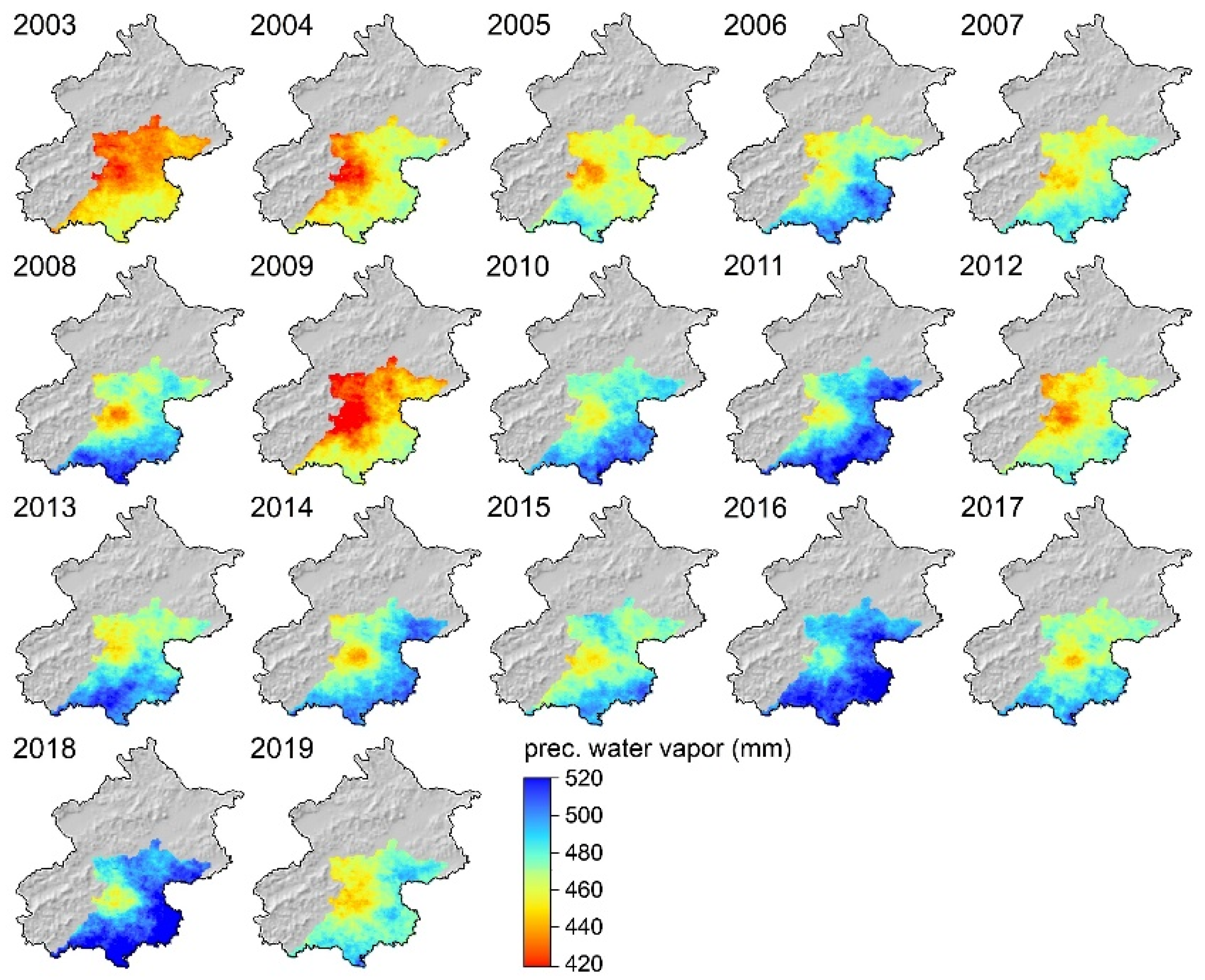
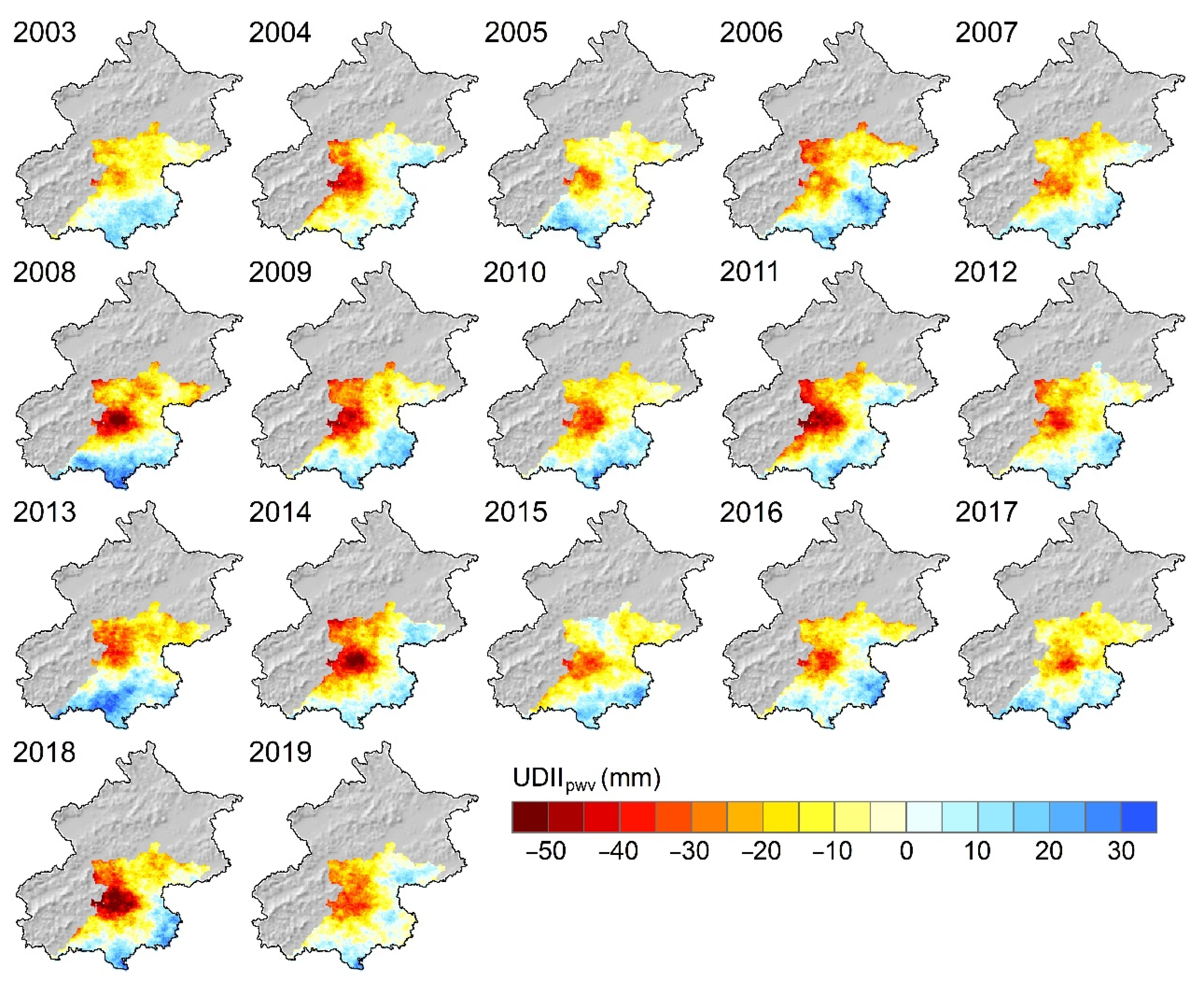



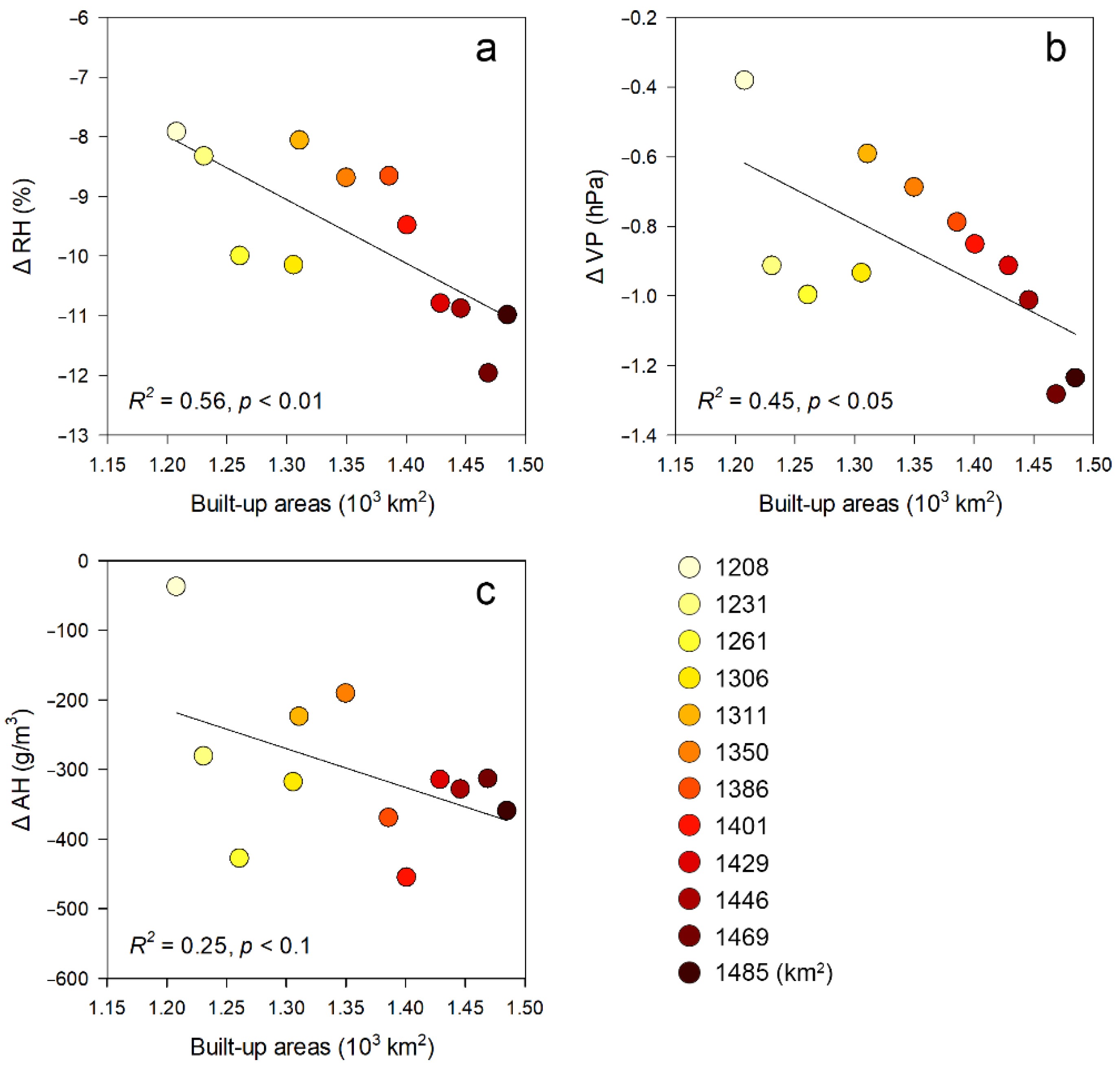
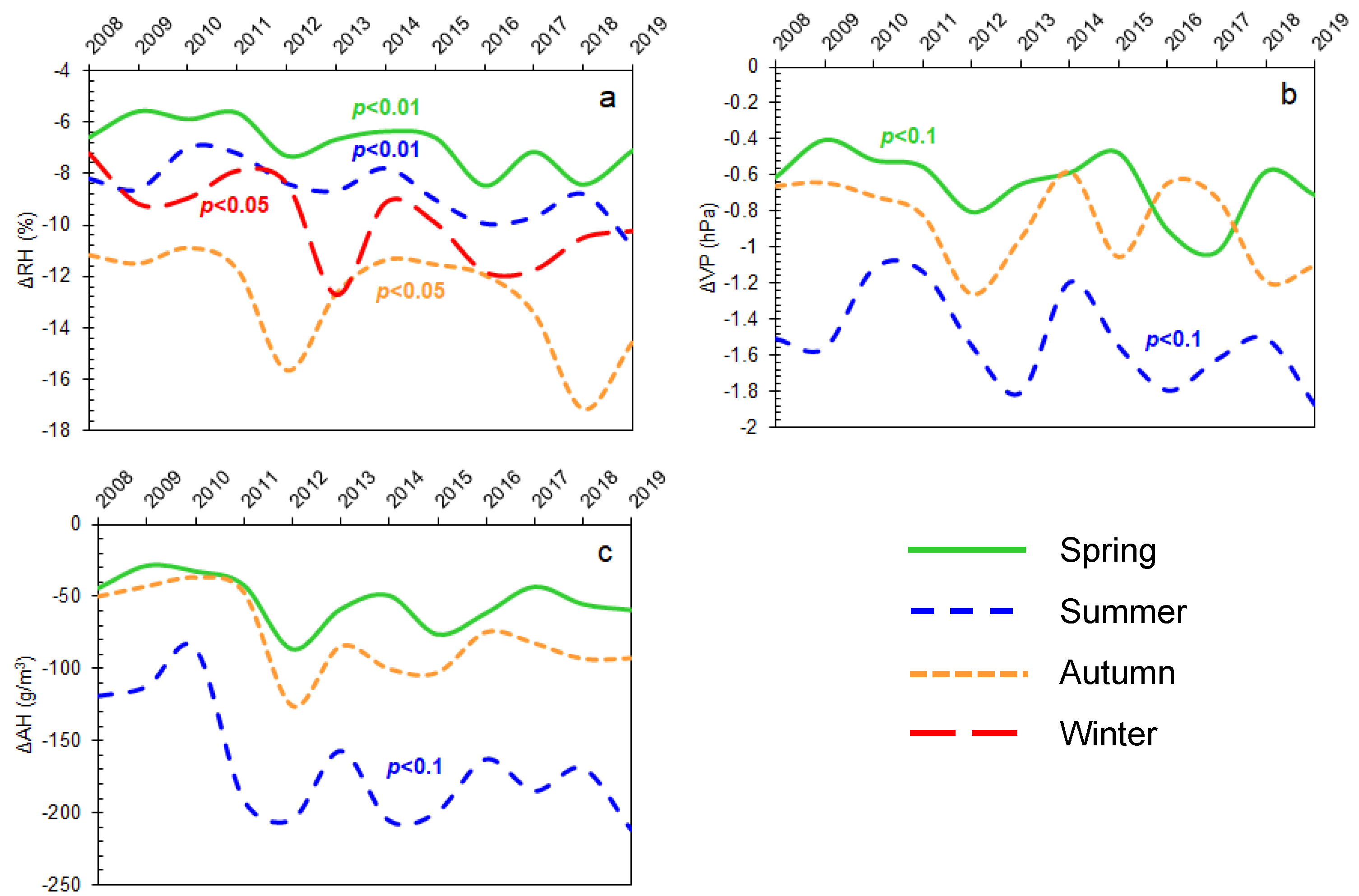
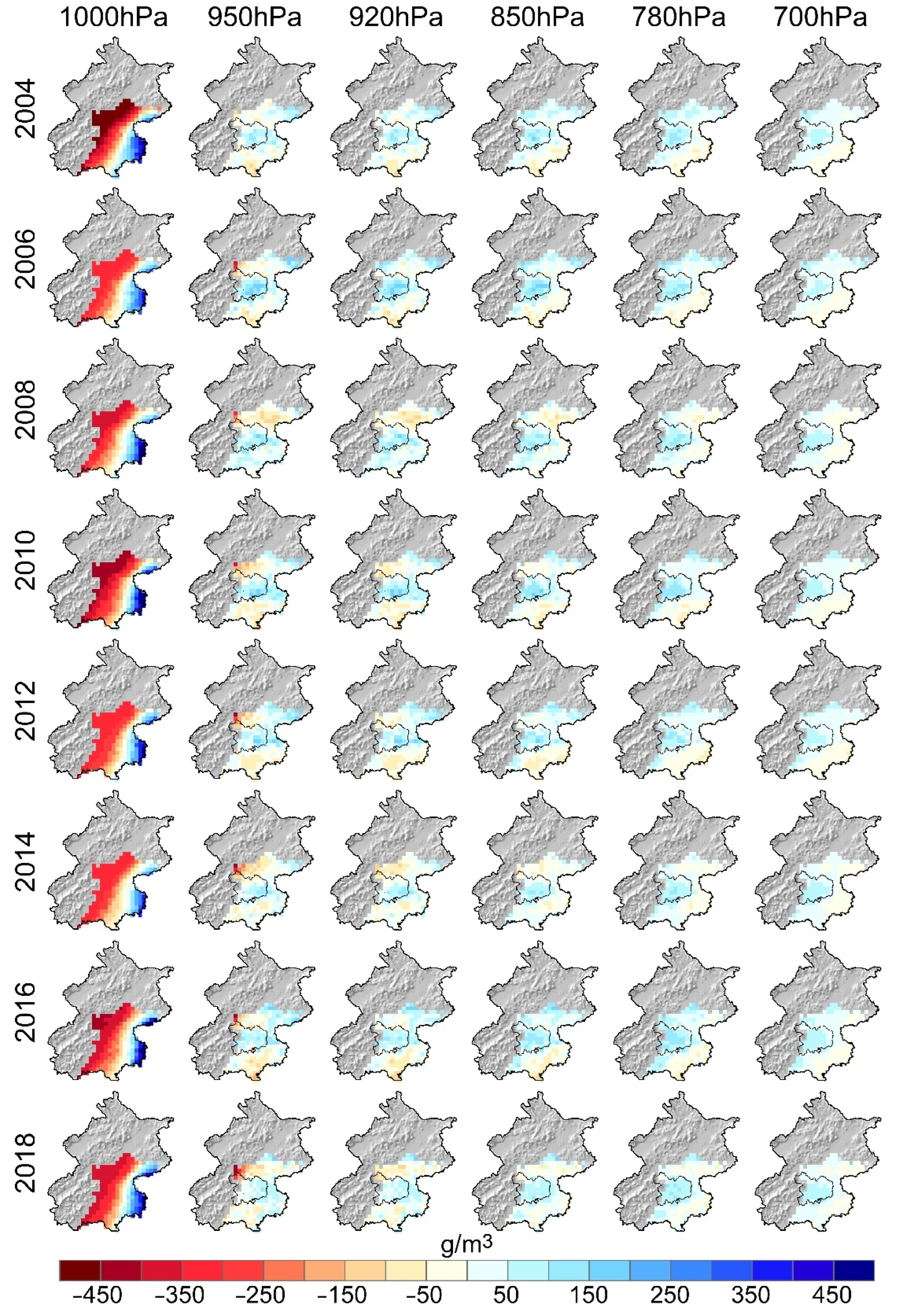
Publisher’s Note: MDPI stays neutral with regard to jurisdictional claims in published maps and institutional affiliations. |
© 2022 by the authors. Licensee MDPI, Basel, Switzerland. This article is an open access article distributed under the terms and conditions of the Creative Commons Attribution (CC BY) license (https://creativecommons.org/licenses/by/4.0/).
Share and Cite
Luan, Q.; Cao, Q.; Huang, L.; Liu, Y.; Wang, F. Identification of the Urban Dry Islands Effect in Beijing: Evidence from Satellite and Ground Observations. Remote Sens. 2022, 14, 809. https://doi.org/10.3390/rs14040809
Luan Q, Cao Q, Huang L, Liu Y, Wang F. Identification of the Urban Dry Islands Effect in Beijing: Evidence from Satellite and Ground Observations. Remote Sensing. 2022; 14(4):809. https://doi.org/10.3390/rs14040809
Chicago/Turabian StyleLuan, Qingzu, Qian Cao, Lei Huang, Yupeng Liu, and Fengjiao Wang. 2022. "Identification of the Urban Dry Islands Effect in Beijing: Evidence from Satellite and Ground Observations" Remote Sensing 14, no. 4: 809. https://doi.org/10.3390/rs14040809
APA StyleLuan, Q., Cao, Q., Huang, L., Liu, Y., & Wang, F. (2022). Identification of the Urban Dry Islands Effect in Beijing: Evidence from Satellite and Ground Observations. Remote Sensing, 14(4), 809. https://doi.org/10.3390/rs14040809







